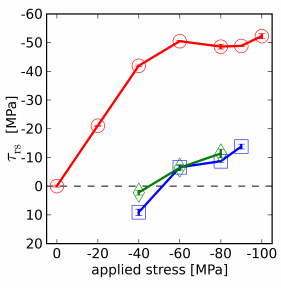The way a material reacts under stress is a question of critical relevance, especially when considering that material’s strength and versatility for various uses. Under stress, hexagonal-close-packed (HCP) metals are known to undergo crystallographic twinning, when parts of a grain abruptly flip and create mirror-image copies of themselves. Because twinning also results in new reoriented grain domains and shear patterns that can affect the mechanical qualities of a metal, a detailed understanding and precise characterization of such behavior is essential for the development and use of predictive models. Working at the U.S. Department of Energy’s Advanced Photon Source (APS) at Argonne, a team of researchers has pioneered a method of using three-dimensional x-ray diffraction (3DXRD) to study the twinning process in low-symmetry materials and its evolution in situ on the level of individual grains, while also allowing the full stress tensor to be measured. Their results were published in Physical Review B Condensed Matter and Materials Physics.
The experimenters—from the Los Alamos, Lawrence Livermore, and Argonne national laboratories—examined cylindrical samples of the magnesium alloy AZ31 on the X-ray Operations and Research 1-ID beamline at the APS, using 3DXRD with a 200-µm x 200-µm synchrotron x-ray beam at 80.7 keV. Compression stress at 20-MPa increments was applied perpendicular to the axis of the x-ray beam while the sample was rotated over 120° along the loading axis. Bragg reflections (diffraction spots) from various grains were picked up by an area detector in several crystallographic planes. Data from the diffraction spots were analyzed by computer to identify grains in twinning orientations. Magnesium was chosen as an experimental material because its hexagonal structure allows twinning to be easily induced under stress.
Previous neutron diffraction studies of AZ31 clarified the need for obtaining data at a finer level of precision than is possible with that method. “We’re looking for experimental input for some of our modeling efforts, looking at how twinning influences deformation of materials in general,” said researcher and co-author Bjørn Clausen. While neutron diffraction provides excellent statistical data, it cannot delineate the individual twinning process in single grains, unlike the 3DXRD technique used in the current work.
The researchers identified three grains that, because of their orientation, were good candidates for twinning, along with another grain in a completely different orientation for use as a control reference. They monitored these grains during the experimental runs as stress was applied. Because the team found that the overlapping of diffraction spots increased with stress, usable signal was no longer generated by two of the grains after a certain point, but the remaining grain displayed a good degree of twinning before it was also overlapped by diffraction spot signals at about 90 MPa.
When the orientation of the parent grain is known, it is possible to calculate the positions of the diffraction spots of the twins, and their subsequent appearance in the predicted locations indicates the presence of that particular twin variant. The grain displayed variants 2 and 5 of the 6 variants in the twinning system (as numbered clockwise around the c axis of the hexagonal unit cell), beginning at 40-MPa of compression. Although all six variants are possible, Clausen points out: “In general, only one is actually generated. And that is the one for which the resolved shear stress on the twin system is the highest. If two of them have a high value of the resolved shear stress, then you can have two. It all depends on the orientation of the parent grain.”
The researchers were able to determine the three-dimensional stress tensors of the parent grain and its twin variants at every stage of evolution with greater precision than previously achieved with the 3DXRD technique. Clausen said, “We set out to measure the actual strain and stress within a single grain inside the magnesium... looking at how the twinning affects the stress state within the grain.”
The team hopes to use the present data to refine their current models to predict how various low-symmetry materials will behave. A future question is how the surrounding grains affect the stresses on the twinning grain. “Statistically, the grains around the parent grain that is twinning will also have some influence,” said Clausen. “Further down the line we would like to actually be able to take into account all the actual grains around, because they are themselves anisotropic. That’s sort of the second order effect that we’re looking to find.”
The models could also eventually be applicable to other hexagonal systems, including magnesium, zirconium, and titanium. “The process of twinning is very similar to martensitic transformations, so one could also think of using the same techniques for looking at domain switching in ferroelectrics and martensitic phase transformation in shape memory alloys,” said Clausen. — Mark Wolverton
See: C.C. Aydıner1*, J.V. Bernier2, B. Clausen1, U. Lienert3, C.N. Tomé1, and D.W. Brown1, “Evolution of stress in individual grains and twins in a magnesium alloy aggregate,” Phys. Rev. B 80, 024113 (2009). DOI: 10.1103/PhysRevB.80.024113
Author affiliations: 1Los Alamos National Laboratory, 2Lawrence Livermore National Laboratory,
3Argonne National Laboratory
Correspondence: can.aydiner@boun.edu.tr, clausen@lanl.gov
This work was supported by the U.S. Department of Energy Office of Basic Energy Science through Project No. FWP 06SCPE401. Use of the Advanced Photon Source was supported by the U.S. Department of Energy, Office of Science, Office of Basic Energy Sciences, under Contract No. DE-AC02-06CH11357.
Argonne National Laboratory seeks solutions to pressing national problems in science and technology. The nation's first national laboratory, Argonne conducts leading-edge basic and applied scientific research in virtually every scientific discipline. Argonne researchers work closely with researchers from hundreds of companies, universities, and federal, state and municipal agencies to help them solve their specific problems, advance America's scientific leadership and prepare the nation for a better future. With employees from more than 60 nations, Argonne is managed by UChicago Argonne, LLC for the U.S. Department of Energy's Office of Science.

